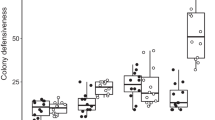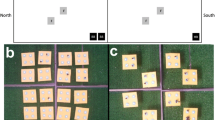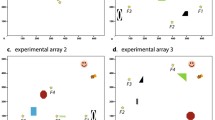Abstract
The ability of a successful forager to activate colony foraging allows colonies to rapidly exploit ephemeral resources and is an important innovation in the evolution of sociality. We tested the ability of the species, Bombus occidentalis, to stimulate colony foraging for food varying in quality. We then analyzed the behavior of successful foragers inside the nest to learn more about potential foraging activation movements. The number of bees entering a foraging arena was positively correlated with food sucrose concentration (0.5, 1.0, and 2.5 M sucrose, equal to 16–65% w/w). Foragers spent significantly more time imbibing higher concentration solutions. Foragers then returned to the nest where they moved in elaborate paths at variable speeds. There was no significant effect of sucrose concentration on average forager velocity or time spent inside the nest. However, the length of a forager’s path inside the nest (total of all distances moved each 0.1 s) significantly increased with sucrose concentration. On average, individuals foraging on 2.5 M and 1.0 M solution walked paths respectively 1.6 fold and 1.4 longer than the paths of individuals foraging on 0.5 M solution. These longer paths could result in a greater number of nestmate contacts, a factor shown to be important in the activation of B. impatiens foragers and also reported in B. terrestris foragers.


Similar content being viewed by others
References
Barth FG, Hrncir M, Jarau S (2008) Signals and cues in the recruitment behavior of stingless bees (Meliponini). J Comp Phys A 194:313–327
Cameron SA (1993) Multiple origins of advanced eusociality in bees inferred from mitochondrial DNA sequences. Proc Natl Acad Sci USA 90:8687–8691
Cameron SA, Hines HM, Williams PH (2007) A comprehensive phylogeny of the bumble bees (Bombus). Biol J Linn Soc 91:161–188
Dornhaus A, Cameron S (2003) A scientific note on food alert in Bombus transversalis. Apidologie 34:87–88
Dornhaus A, Chittka L (1999) Evolutionary origins of bee dances. Nature 401:38
Dornhaus A, Chittka L (2001) Food alert in bumblebees (Bombus terrestris): possible mechanisms and evolutionary implications. Behav Ecol Sociobiol 50:570–576
Dornhaus A, Chittka L (2004) Information flow and foraging decisions in bumble bees (Bombus spp.). Apidologie 35:183–192
Dornhaus A, Chittka L (2005) Bumble bees (Bombus terrestris) store both food and information in honeypots. Behav Ecol 16:661–666
Dornhaus A, Brockmann A, Chittka L (2003) Bumble bees alert to food with pheromone from tergal gland. J Comp Phys A 189:47–51
Goulson D (2003) Effects of introduced bees on native ecosystems. Ann Rev Ecol Evol Syst 34:1–26
Harder LD (1986) Effects of nectar concentration and flower depth on flower handling efficiency of bumblebees. Oecologia 69:309–315
Hrncir M, Jarau S, Zucchi R, Barth FG (2000) Recruitment behavior in stingless bees, Melipona scutellaris and M. quadrifasciata. II. possible mechanisms of communication. Apidologie 31:93–113
Kearns CA, Inouye DW (1993) Techniques for pollination biologists. University Press of Colorado, Niwot
Kitaoka TK, Nieh JC (2009) Bumble bee pollen foraging regulation: role of pollen quality, storage levels, and odor. Behav Ecol Sociobiol 63:501–510
Lindauer M, Kerr WE (1958) Die gegenseitige Verständigung bei den stachellosen Bienen. Z Vergl Physiol 41:405–434
Oeynhausen A, Kirchner WH (2001) Vibrational signals of foraging bumblebees (Bombus terrestris) in the nest. In: Proceedings of the Meeting of the European Sections of IUSSI, Berlin. pp. 25–29
Pleasants JM (1981) Bumblebee response to variation in nectar availability. Ecology 62:1648–1661
Rao S, Stephen WP (2007) Bombus (Bombus) occidentalis (Hymenoptera: Apiformes): in decline or recovery? Pan-Pac Entomol 83:360–362
Renner M, Nieh JC (2008) Bumble bee olfactory information flow and contact-based foraging activation. Insectes Soc 55:417–424
Rohrseitz K, Tautz J (1999) Honey bee dance communication: waggle run direction coded in antennal contacts? J Comp Phys A 184:463–470
Roubik DW, Buchmann SL (1984) Nectar selection by Melipona and Apis mellifera (Hymenoptera: Apidae) and the ecology of nectar intake by bee colonies in a tropical forest. Oecologia 61:1–10
Schmidt VM, Hrncir M, Schorkopf DL, Mateus S, Zucchi R, Barth F (2008) Food profitability affects intranidal recruitment behavior in the stingless bee Nannotrigona testaceicornis. Apidologie 39:260–272
Thomson JD (1986) Pollen transport and deposition by bumble bees in Erythronium: influences of floral nectar and bee grooming. J Ecol 74:329–342
Thomson D (2004) Competitive interactions between the invasive European honey bee and native bumble bees. Ecology 85:458–470
Thorpe RW (2005) Bombus franklini Frison, 1921. Franklin’s Bumble Bee (Hymenoptera: Apidae: Apinae: Bombini). In: Shepherd MD, Vaughan DM, Black SH (eds) Red list of pollinator insects of North America, CD-ROM version 1 edn. The Xerces Society for Invertebrate Conservation, Portland
von Frisch K (1967) The dance language and orientation of bees, 2nd printing, 1993rd edn. Belknap, Cambridge
Whittington R, Winston ML (2003) Effects of Nosema bombi and its treatment fumagillin on bumble bee (Bombus occidentalis) colonies. J Invertebr Pathol 84:54–58
Wilson ES, Holway D, Nieh JC (2006) Cold anesthesia decreases foraging recruitment in the New World bumblebee, Bombus occidentalis. J Api Res 45:169–172
Zar JH (1984) Biostatistical analysis, 2nd edn. Prentice-Hall, Englewood Cliffs
Acknowledgements
We would like to thank the reviewers who provided valuable comments on this manuscript and the many individuals who helped in the experiments and analysis: Laura Stamm, Katherine Nguyen, Jeremy Song, Amy Lin, Megan Eckles, Peter Tang, Erin Loomis, and Erin Wilson. The Opportunities for Research in the Behavioral Sciences (ORBS) Program at UCSD, the UCSD Heiligenberg Endowment, and NSF Grant 0316697 supported this research.
Author information
Authors and Affiliations
Corresponding author
Rights and permissions
About this article
Cite this article
Nguyen, H., Nieh, J.C. Colony and Individual Forager Responses to Food Quality in the New World Bumble Bee, Bombus occidentalis . J Insect Behav 25, 60–69 (2012). https://doi.org/10.1007/s10905-011-9277-5
Revised:
Accepted:
Published:
Issue Date:
DOI: https://doi.org/10.1007/s10905-011-9277-5




